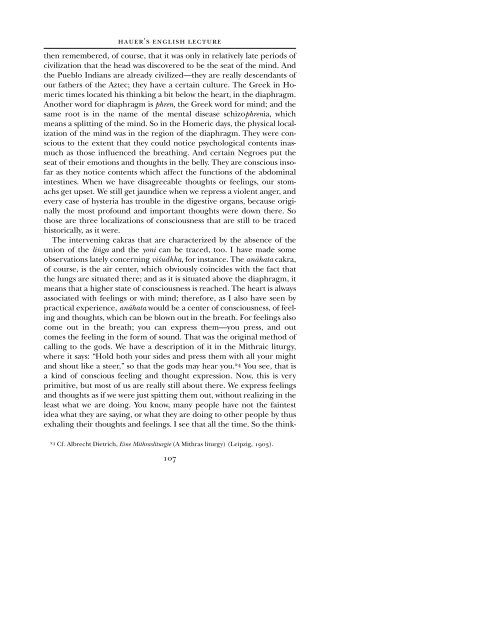CG JUNG - Countryside Anarchist
CG JUNG - Countryside Anarchist
CG JUNG - Countryside Anarchist
You also want an ePaper? Increase the reach of your titles
YUMPU automatically turns print PDFs into web optimized ePapers that Google loves.
HAUER'S ENGLISH LECTURE<br />
then remembered, of course, that it was only in relatively late periods of<br />
civilization that the head was discovered to be the seat of the mind. And<br />
the Pueblo Indians are already civilized—they are really descendants of<br />
our fathers of the Aztec; they have a certain culture. The Greek in Homeric<br />
times located his thinking a bit below the heart, in the diaphragm.<br />
Another word for diaphragm is phren, the Greek word for mind; and the<br />
same root is in the name of the mental disease schizophrenia, which<br />
means a splitting of the mind. So in the Homeric days, the physical localization<br />
of the mind was in the region of the diaphragm. They were conscious<br />
to the extent that they could notice psychological contents inasmuch<br />
as those influenced the breathing. And certain Negroes put the<br />
seat of their emotions and thoughts in the belly. They are conscious insofar<br />
as they notice contents which affect the functions of the abdominal<br />
intestines. When we have disagreeable thoughts or feelings, our stomachs<br />
get upset. We still get jaundice when we repress a violent anger, and<br />
every case of hysteria has trouble in the digestive organs, because originally<br />
the most profound and important thoughts were down there. So<br />
those are three localizations of consciousness that are still to be traced<br />
historically, as it were.<br />
The intervening cakras that are characterized by the absence of the<br />
union of the li´ga and the yoni can be traced, too. I have made some<br />
observations lately concerning viçudhha, for instance. The anvhata cakra,<br />
of course, is the air center, which obviously coincides with the fact that<br />
the lungs are situated there; and as it is situated above the diaphragm, it<br />
means that a higher state of consciousness is reached. The heart is always<br />
associated with feelings or with mind; therefore, as I also have seen by<br />
practical experience, anvhata would be a center of consciousness, of feeling<br />
and thoughts, which can be blown out in the breath. For feelings also<br />
come out in the breath; you can express them—you press, and out<br />
comes the feeling in the form of sound. That was the original method of<br />
calling to the gods. We have a description of it in the Mithraic liturgy,<br />
where it says: “Hold both your sides and press them with all your might<br />
and shout like a steer,” so that the gods may hear you. 24 You see, that is<br />
a kind of conscious feeling and thought expression. Now, this is very<br />
primitive, but most of us are really still about there. We express feelings<br />
and thoughts as if we were just spitting them out, without realizing in the<br />
least what we are doing. You know, many people have not the faintest<br />
idea what they are saying, or what they are doing to other people by thus<br />
exhaling their thoughts and feelings. I see that all the time. So the think-<br />
24 Cf. Albrecht Dietrich, Eine Mithrasliturgie (A Mithras liturgy) (Leipzig, 1903).<br />
107


